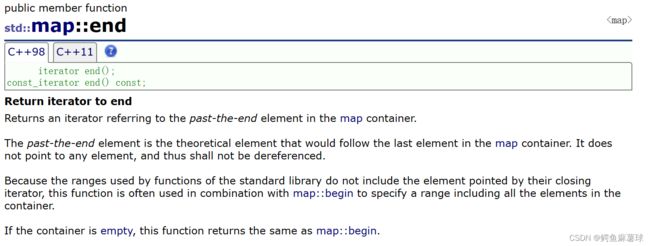【C++】STL——map的介绍和使用、map的构造函数、map的迭代器、map的容量和访问函数、map的增删查改函数
文章目录
- 1.map的介绍
- 2.map的使用
-
- 2.1map的构造函数
- 2.2map的迭代器
- 2.3map的容量和访问函数
- 2.4map的增删查改函数
1.map的介绍
map的介绍
(1)map是关联容器,它按照特定的次序(按照key来比较)存储由键值key和值value组合而成的元素。
(2)在map中,键值key通常用于排序和惟一地标识元素,而值value中存储与此键值key关联的内容。键值key和值value的类型可能不同,并且在map的内部,key与value通过成员类型value_type绑定在一起,为其取别名称为pair:
typedef pair
(3)在内部,map中的元素总是按照键值key进行比较排序的。
(4)map中通过键值访问单个元素的速度通常比unordered_map容器慢,但map允许根据顺序对元素进行直接迭代(即对map中的元素进行迭代时,可以得到一个有序的序列)。
(5)map支持下标访问符,即在[]中放入key,就可以找到与key对应的value。
(6)map通常被实现为二叉搜索树(更准确的说:平衡二叉搜索树。
2.map的使用
map提供的模版参数列表:
key: 键值对中key的类型
T: 键值对中value的类型
Compare: 比较器的类型, map中的元素是按照key来比较的,缺省情况下按照小于来比较,一般情况下(内置类型元素)该参数不需要传递,如果无法比较时(自定义类型),需要用户自己显式传递比较规则(一般情况下按照函数指针或者仿函数来传递)
Alloc:通过空间配置器来申请底层空间, 不需要用户传递,除非用户不想使用标准库提供的空间配置器
2.1map的构造函数
| 函数声明 | 功能介绍 |
|---|---|
| map (const Compare& comp = Compare(), const Allocator& = Allocator() ); | 构造空的map |
| map(InputIterator first, InputIterator last, const Compare& comp = Compare(), const Allocator& = Allocator(()); | 用[first, last)区间中的元素构造map |
| map( const map |
map的拷贝构造 |
以下是一些set构造函数的简单示例:
//1.默认构造函数:创建一个空的map对象。
std::map<int, std::string> myMap;
//通过传入键值对来创建map对象。
std::map<int, std::string> myMap = {{1, "apple"}, {2, "banana"}, {3, "orange"}};
//2.用迭代器构造:通过使用迭代器范围来构造map对象。
std::vector<std::pair<int, std::string>> vec = {{1, "apple"}, {2, "banana"}, {3, "orange"}};
std::map<int, std::string> myMap(vec.begin(), vec.end());
//3.拷贝构造函数:通过拷贝另一个map对象来创建一个新的map对象。
std::map<int, std::string> originalMap = {{1, "apple"}, {2, "banana"}, {3, "orange"}};
std::map<int, std::string> copiedMap(originalMap);
2.2map的迭代器
和set一样,map也有同样的迭代器:
| 函数声明 | 功能介绍 |
|---|---|
| begin()和end() | begin:首元素的位置,end最后一个元素的下一个位置 |
| cbegin()和cend() | 与begin和end意义相同,但cbegin和cend所指向的元素不能修改 |
| rbegin()和rend() | 反向迭代器,rbegin在end位置,rend在begin位置,其++和–操作与begin和end操作移动相反 |
| crbegin()和crend() | 与rbegin和rend位置相同,操作相同,但crbegin和crend所指向的元素不能修改 |
map的迭代器的使用示例:
#include
2.3map的容量和访问函数
注意:在元素访问时,有一个与operator[]类似的操作at()(该函数不常用)函数,都是通过key找到与key对应的value然后返回其引用,不同的是:当key不存在时,operator[]用默认value与key构造键值对然后插入,返回该默认value,at()函数直接抛异常。
| 函数声明 | 功能简介 |
|---|---|
| bool empty ( ) const | 检测map中的元素是否为空,是返回true,否则返回false |
| size_type size() const | 返回map中有效元素的个数 |
| mapped_type& operator[] (const key_type& k) | 返回去key对应的value |
map的容量和访问函数使用:
在示例中,首先使用empty函数检查map是否为空,然后使用size函数获取map的大小。接下来,使用operator[]函数插入键值对到map中。再次使用empty函数和size函数检查map的状态。最后,使用operator[]函数访问map中的值。
#include
2.4map的增删查改函数
| 函数声明 | 功能简介 |
|---|---|
| pair |
在map中插入键值对x,注意x是一个键值对,返回值也是键值对:iterator代表新插入元素的位置,bool代表释放插入成功 |
| void erase ( iterator position ) | 删除position位置上的元素 |
| size_type erase ( const key_type& x ) | 删除键值为x的元素 |
| void erase ( iterator first, iterator last ) | 删除[first, last)区间中的元素 |
| void swap ( map |
交换两个map中的元素 |
| void clear ( ) | 将map中的元素清空 |
| iterator find ( const key_type& x ) | 在map中插入key为x的元素,找到返回该元素的位置的迭代器,否则返回end |
| const_iterator find ( const key_type& x ) const | 在map中插入key为x的元素,找到返回该元素的位置的const迭代器,否则返回cend |
| size_type count ( const key_type& x ) const | 返回key为x的键值在map中的个数,注意map中key是唯一的 |
这里简单举例map的insert和erase:
#include








